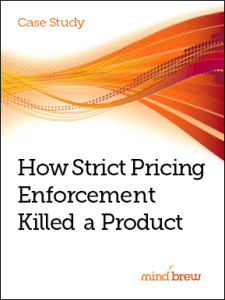At PricingBrew, we talk a lot about price segmentation. In fact, this morning I did a keyword search of the Journal subscriber portal…which is a very handy feature, BTW…and found more than 50 educational resources that broach the topic. As Editor in Chief, this pleases me greatly as price segmentation is one of the most powerful, yet least understood, aspects of effective pricing in B2B environments.
I must admit, however, that when we talk about developing very granular segmentation models with thousands, tens of thousands, or even hundreds of thousands of price segments, it tends to be make people’s heads explode, like in the Scanners movie. (Look it up, young people.)
It’s somewhat axiomatic that a more granular segmentation will give you much greater ability to extract revenue and profit than a coarse segmentation. Nevertheless, it can be difficult for people to envision developing and managing 100,000 price segments, let alone executing 100,000 price segments in the field.
That’s one of the reasons I enjoyed a new book by Jim Vaughn called, “Stop Racing in a Blindfold: How Big Data Plus Pricing Science Drives Bigger Profits.” In his book, Jim does a great job of explaining the mechanics behind granular price segmentation and optimization models—how they work, how they’re developed, how they’re executed in the field, and so on.
After reading the book, I got Jim to participate in an Expert Interview for the Journal and we spent over an hour discussing these concepts. You can listen to the interview and read the book for yourself, but I think one of the big takeaways is this:
It’s not nearly as complicated as it may seem. And once you understand how these things are done…i.e. “how the sausage is made”…the idea of having a pricing model with 100,000 price segments isn’t really that big of a deal.
In fact, when you really understand how it’s done, you realize that you’re not actively developing and managing 100,000 price segments at all!
In reality, you’re just identifying the handful of major customer, product, and order attributes that drive or indicate differences in willingness-to-pay. Then, for each of those attributes or along each of those dimensions, there may be a number of “buckets” or breaks. Depending on the size of your product catalog and customer base, sure, all of the possible combinations or permutations of those attributes and breakpoints may equate to 100,000 price segments.
But you’re not really setting out to identify, develop, manage, and execute 1000, 10,000, or 100,000 price segments—they’re simply the result of an equation involving a much smaller and far more manageable set of variables.
So, don’t be intimidated or put-off by the big numbers. Learn how this stuff is really done. Unlike sausage, the more you know about how granular price segmentation models are actually made, the less scary they become.














